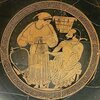In Athens, marriage was viewed as a tool for ensuring a legal heir. This was especially true for the period of Pericles since, according to the laws of the famous statesman, only those whose mother and father were both from Athens could be citizens of the
polis. As a result, a wife's only job was to ensure the continuity of the lineage.
Women of the Athens aristocracy married young, at thirteen to fifteen years old, and were respected if they remained quiet and unnoticed.
Wives lived secluded from the world in the
gunaikeion, the women’s quarters. They did not eat with their husbands or sleep together. And since, due to their upbringing, they were completely uncultured, conversations between spouses were also very rare. In a man's life, the wife usually wasn't the only woman with whom he interacted sexually. Women sometimes had to share their homes with their husband's mistresses, because they had no say in what went on in the
andron, the men's quarters in the house.

The ancient Greeks believed that women had far greater sexual appetites than men, and thus found it very difficult to control their instincts. This is how they explained the fact that despite living hermetically cut off from the outside world, they often committed adultery. And husbands did not easily tolerate being cheated on. The laws of Athens allowed the cuckolded man to kill his wife's lover without fear of punishment. The unfaithful wife could not participate in religious ceremonies, could not improve her appearance, and was even prohibited from going to church.
The husband could at any time divorce his wife, and had the possibility of offering the woman to another man without her consent. Women in this respect were at a disadvantage compared to men, as they could only initiate divorce through a mediating relative, on the basis of mistreatment, and the children always stayed under the father's custody.

It is known lesbianism and queer relations happened during ancient Greece, yet their documentation or their acknowledgment during this time is extremely limited. Ancient Greece was a patriarchal society that neglected women, as a result, women’s lives were not always documented realistically. Consequently, Lesbianism in ancient Greek society was misunderstood and largely unaccounted for. This is evident through the social focus on male sexuality. Second, by the invisibility of female sexuality. Along with the heterosexualizing of lesbian relationships.










